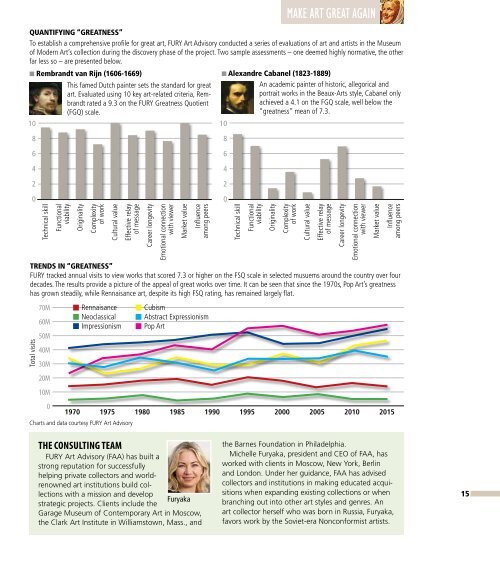artenol0416_sm_flipbook
You also want an ePaper? Increase the reach of your titles
YUMPU automatically turns print PDFs into web optimized ePapers that Google loves.
MAKE ART GREAT AGAIN<br />
QUANTIFYING “GREATNESS”<br />
To establish a comprehensive profile for great art, FURY Art Advisory conducted a series of evaluations of art and artists in the Museum<br />
of Modern Art’s collection during the discovery phase of the project. Two sample asses<strong>sm</strong>ents – one deemed highly normative, the other<br />
far less so – are presented below.<br />
n Rembrandt van Rijn (1606-1669)<br />
n Alexandre Cabanel (1823-1889)<br />
10<br />
This famed Dutch painter sets the standard for great<br />
art. Evaluated using 10 key art-related criteria, Rembrandt<br />
rated a 9.3 on the FURY Greatness Quotient<br />
(FGQ) scale.<br />
10<br />
An academic painter of historic, allegorical and<br />
portrait works in the Beaux-Arts style, Cabanel only<br />
achieved a 4.1 on the FGQ scale, well below the<br />
“greatness” mean of 7.3.<br />
8<br />
6<br />
4<br />
2<br />
8<br />
6<br />
4<br />
2<br />
0<br />
Technical skill<br />
Functional<br />
viability<br />
Originality<br />
Complexity<br />
of work<br />
Cultural value<br />
Effective relay<br />
of message<br />
Career longevity<br />
Emotional connection<br />
with viewer<br />
Market value<br />
Influence<br />
among peers<br />
TRENDS IN “GREATNESS”<br />
FURY tracked annual visits to view works that scored 7.3 or higher on the FSQ scale in selected musuems around the country over four<br />
decades. The results provide a picture of the appeal of great works over time. It can be seen that since the 1970s, Pop Art’s greatness<br />
has grown steadily, while Rennaisance art, despite its high FSQ rating, has remained largely flat.<br />
Total visits<br />
70M<br />
60M<br />
50M<br />
40M<br />
30M<br />
20M<br />
10M<br />
0<br />
Rennaisance<br />
Neoclassical<br />
Impressioni<strong>sm</strong><br />
Cubi<strong>sm</strong><br />
Abstract Expressioni<strong>sm</strong><br />
Pop Art<br />
1970 1975 1980 1985 1990 1995 2000 2005 2010 2015<br />
Charts and data courtesy FURY Art Advisory<br />
0<br />
Technical skill<br />
Functional<br />
viability<br />
Originality<br />
Complexity<br />
of work<br />
Cultural value<br />
Effective relay<br />
of message<br />
Career longevity<br />
Emotional connection<br />
with viewer<br />
Market value<br />
Influence<br />
among peers<br />
THE CONSULTING TEAM<br />
FURY Art Advisory (FAA) has built a<br />
strong reputation for successfully<br />
helping private collectors and worldrenowned<br />
art institutions build collections<br />
with a mission and develop<br />
strategic projects. Clients include the<br />
Furyaka<br />
Garage Museum of Contemporary Art in Moscow,<br />
the Clark Art Institute in Williamstown, Mass., and<br />
the Barnes Foundation in Philadelphia.<br />
Michelle Furyaka, president and CEO of FAA, has<br />
worked with clients in Moscow, New York, Berlin<br />
and London. Under her guidance, FAA has advised<br />
collectors and institutions in making educated acquisitions<br />
when expanding existing collections or when<br />
branching out into other art styles and genres. An<br />
art collector herself who was born in Russia, Furyaka,<br />
favors work by the Soviet-era Nonconformist artists.<br />
15

















